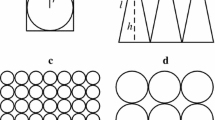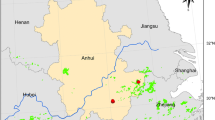Abstract
Relationships between diameter at breast height (dbh) versus stand density, and tree height versus dbh (height curve) were explored with the aim to find if there were functional links between correspondent parameters of the relationships, exponents and intercepts of their power functions. A geometric model of a forest stand using a conic approximation suggested that there should be interrelations between correspondent exponents and intercepts of the relationships. It is equivalent to a type of ‘relationship between relationships’ that might exist in a forest stand undergoing self-thinning, and means that parameters of one relationship may be predicted from parameters of another. The predictions of the model were tested with data on forest stand structure from published databases that involved a number of trees species and site quality levels. It was found that the correspondent exponents and intercepts may be directly recalculated from one another for the simplest case when the total stem surface area was independent of stand density. For cases where total stem surface area changes with the drop of density, it is possible to develop a generalization of the model in which the interrelationships between correspondent parameters (exponents and intercepts) may be still established.


Similar content being viewed by others
References
Chapman HH (1921) Forest mensuration. Wiley, New York, p 553
Gavrikov VL (2014) A simple theory to link bole surface area, stem density and average tree dimensions in a forest stand. Eur J For Res 133(6):1087–1094. doi:10.1007/s10342-014-0824-4
Gavrikov VL (2015) An application of bole surface growth model: a transitional status of ‘−3/2’ rule. Eur J For Res 134(4):715–724
Inoue A (2004) Relationships of stem surface area to other stem dimensions for Japanese cedar (Cryptomeria japonica D. Don) and Japanese cypress (Chamaecyparis obtusa Endl.) trees. J For Res 9(1):45–50
Inoue A (2009) Allometric model of the maximum size–density relationship between stem surface area and stand density. J For Res 14(5):268–275
Inoue A, Nishizono T (2015) Conservation rule of stem surface area: a hypothesis. Eur J For Res 134(4):599–608
Larjavaara M (2010) Maintenance cost, toppling risk and size of trees in a self-thinning stand. J Theor Biol 265(1):63–67
Niklas KJ, Spatz HC (2004) Growth and hydraulic (not mechanical) constraints govern the scaling of tree height and mass. Proc Natl Acad Sci USA 101(44):15661–15663
Pretzsch H (2006) Species-specific allometric scaling under self-thinning: evidence from long-term plots in forest stands. Oecologia 146(4):572–583
Pretzsch H, Biber P (2005) A re-evaluation of Reineke’s rule and stand density index. For Sci 51(4):304–320
Reineke LH (1933) Perfecting a stand-density index for even-aged forests. J Agric Res 46(7):627–638
Sterba H (1987) Estimating potential density from thinning experiments and inventory data. For Sci 33(4):1022–1034
Usoltsev VA (2010) Eurasian forest biomass and primary production data. Ural Branch of Russian Academy of Sciences, Yekaterinburg, p 570 (in Russian)
van Laar A, Akça A (2007) Forest mensuration. In: Gadow KV, Pukkala T, Tomé M (eds) Managing forest ecosystems, vol 13. Springer, Dordrecht, p 384
Vanclay JK, Sands PJ (2009) Calibrating the self-thinning frontier. For Ecol Manag 259(1):81–85
Yoda K, Kira T, Ogawa H, Hozumi K (1963) Intraspecific competition among higher plants. XI. Self-thinning in over-crowded pure stands under cultivated and natural conditions. J Biol Osaka City Univ 14:107–129
Zhang Z, Zhong Q, Niklas KJ, Cai L, Yang Y, Cheng D (2016) A predictive nondestructive model for the covariation of tree height, diameter, and stem volume scaling relationships. Sci Rep 6:31008. doi:10.1038/srep31008
Acknowledgements
Dr. G. Kofman read the manuscript and made useful suggestions which are gratefully acknowledged. The author thanks two anonymous reviewers who made useful comments that helped to improve the manuscript.
Author information
Authors and Affiliations
Corresponding author
Additional information
Project funding: The study was in part supported by a research grant from the Russian Foundation for Basic Research ‘Impact of climate change on productivity of forest landscapes of Central Siberia: reconstruction of landscape dynamics in holocene and prognosis of tendencies of substance turnover in the landscapes’.
The online version is available at http://www.springerlink.com
Corresponding editor: Chai Ruihai.
Electronic supplementary material
Below is the link to the electronic supplementary material.
Rights and permissions
About this article
Cite this article
Gavrikov, V.L. ‘Relationships between relationships’ in forest stands: intercepts and exponents analyses. J. For. Res. 29, 575–582 (2018). https://doi.org/10.1007/s11676-017-0475-7
Received:
Accepted:
Published:
Issue Date:
DOI: https://doi.org/10.1007/s11676-017-0475-7




